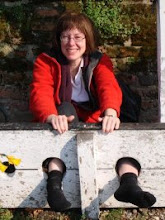




Sheila asked me to tell more about the edges of the quilts that I am showing. This reminded me of an Area Day we had at Bentwaters, an American Airbase near Woodbridge, in the early 90's. One of the speakers was Dorothy Osler - she was asked the difference between American and British quilts. Unerringly, she singled out my quilt and Kay Michalak's quilt - the ones made by two Americans present! The skinny borders and block format were an easy giveaway as were the use of light background fabrics - but in earlier times it could just as easily have been the binding treatment. American and Canadian quilts (plus modern quilts which are usually in the imported American quilt revival style)have bindings applied to the edges.
British quilts (until the 1960's when American quilting books became available here) generally had a butt or knife edge unless a worn edge had been repaired. In the butt edge, the wadding or batting is trimmed back and the edges turned in. Purists insisted the edges be secured by neat hand stitching but many preferred a line or two of machine stitching to give a sturdy and firm edge. The funny thing is, after the careful hand quilting the machine stitching is often very slapdash!! Another treatment popular in the 20's and 30's was the frilled edge - here a ruffle was enclosed in the butt edge. Beds were getting larger and the ruffle was an easy way to increase the effective size of the quilt. Frills often got very worn and many quilts have had frills chopped off at some later date.
Generally speaking, north country quilts had machine stitched edges whereas Welsh quilts had hand stitched edges (just a generalisation of course). I apologise about these photos which are not very exciting! They show a frill, the welsh strippy with a hand stitched edge, and north country quilts with one and two lines of machine stitching. Also one quilt from Rothbury Northumberland where the quilter made a curved line with the sewing machine!!

I find the photos exciting. Thank you for sharing your expertise with us.
ReplyDeleteSo sweet of you to oblige! Thank you.
ReplyDeleteGreat photos - they explain the different edge finishes so well. One of my earliest quilts has a "Welsh-style" hand sewn edge because I didn't know how to do a binding and I'd seen quilts with that finish in Aberystwyth in the 1980s (in the exhibition that used to be upstairs over the railway station and in the Cambrian Museum). I should try it again.
ReplyDeleteWhat a great idea to photograph the edging on your old quilts, Pippa, and to share them with us! Blogging is such a fantastic way to share all our collecting and exploring with one another. What a difference it makes in the quilt study world!
ReplyDelete